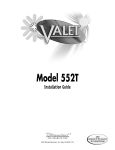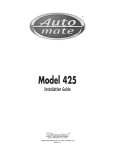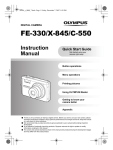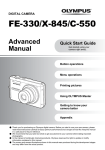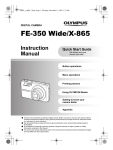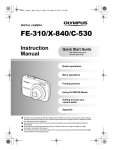Download Directed Electronics Automate 552 User's Manual
Transcript
® Model 552 Installation Guide ® © 1999 Directed Electronics, Inc. Vista, CA N552A 12-99 Downloaded from: http://www.guardianalarms.net table of contents What Is Included . . . . . . . . . . . . . . . . . . . . . 3 Plug-in LED and Valet®/Program Switch . . . . . 23 Warning! Safety First . . . . . . . . . . . . . . . . . . 4 Harness 4, (+/-) Door Lock Outputs Type A . . . . . . . . . . . . . . . . . . Type B . . . . . . . . . . . . . . . . . . Type C . . . . . . . . . . . . . . . . . . Type D . . . . . . . . . . . . . . . . . . Type E . . . . . . . . . . . . . . . . . . Type F . . . . . . . . . . . . . . . . . . Installation Points to Remember . . . . . . . . . . 5 Deciding On Component Locations Control Module. . . . . . . . . . . . Valet®/Program Switch . . . . . . Status LED . . . . . . . . . . . . . . Starter Kill Relay . . . . . . . . . . . . . . . . . . . . . . . . . . . . . . . . . . . . . . . . . . . . . . . . . . . . . . . 5 5 6 6 7 Finding The Wires You Need. . . . . . . . . . . . . . 7 Obtaining Constant 12V . . . . . . . . . . . . . . . 7 12V Switched Ignition Wire . . . . . . . . . . . . 8 Starter Wire. . . . . . . . . . . . . . . . . . . . . . . 8 (+/-) Parking Light Wire. . . . . . . . . . . . . . . 9 Accessory Wire . . . . . . . . . . . . . . . . . . . . 10 Tachometer Wire . . . . . . . . . . . . . . . . . . . 10 Wait-To-Start Bulb Wire For Diesels . . . . . . . 10 Wiring the Control Unit . . . . . . . . . . . . . . . . 11 Wiring Diagrams . . . . . . . . . . . . . . . . . . . . . Primary Harness (H1) Wiring Diagram . . . . . Remote Start Ribbon Harness Wiring Diagram . Heavy Gauge Relay Satellite Wiring Diagram . (H2) Harness Auxiliary Connector Wiring Diagram . . . . . . . . . . . . . . . . . . . Remote Start Harness (H3) Wiring Diagram. . 11 11 11 12 Wire Connection Guides . . . . . . . . . . . . Primary Harness (H1), 8-Pin Connector Relay Satellite Key Switch Interface . . Harness 2 (H2), 2-Pin Auxiliary Plug . . Remote Start Harness (H3) . . . . . . . . 13 13 16 17 18 . . . . . . . . . . . . . . . . . . . . 12 12 Neutral Safety Switch Interface . . . . . . . . . . 20 General Motors Trucks, SUVs, and Column Shifting Passenger Cars . . . . . . . . . . . . . . 21 Pre-1996 Dodge Dakota Pickups with 2.5 Liter Motors . . . . . . . . . . . . . . . . . . . 22 . . . . . . . . . . . . . . . . . . . . . . . . . . . . . . . . . . . . . . . . . . . . . . . . . 23 24 25 26 27 28 28 Internal Programming Jumpers . . . . . . . . . . . 29 Light Flash Jumper . . . . . . . . . . . . . . . . . 29 Digital Tach Threshold On/Off . . . . . . . . . . 29 Transmitter/Receiver Learn Routine. . . . . . . . 30 Tach Learning . . . . . . . . . . . . . . . . . . . . . . . 32 Operating-Settings Learn Routine . . . . . . . . . 32 To Program the Learn Routine . . . . . . . . . . 33 To Exit the Learn Routine . . . . . . . . . . . . . 34 Feature Menus . . . . . . . . . . . . . . . . . . . . . . 34 Menu #1 . . . . . . . . . . . . . . . . . . . . . . . . 34 Menu #2 . . . . . . . . . . . . . . . . . . . . . . . . 35 Feature Descriptions . . . . . . . . . . . . . . . . . . 35 Menu #1 . . . . . . . . . . . . . . . . . . . . . . . . 35 Menu #2 . . . . . . . . . . . . . . . . . . . . . . . . 36 Shutdown Diagnostics . . . . . . . . . . . . . . . . . 38 To Enter Diagnostic Mode . . . . . . . . . . . . . 38 Valet® Mode. . . . . . . . . . . . . . . . . . . . . . . . 39 To Enter or Exit Valet Mode . . . . . . . . . . . . 39 Timer Mode . . . . . . . . . . . . . . . . . . . . . . . . 39 To Enter or Exit Timer Mode . . . . . . . . . . . 39 To Exit Timer Mode Manually . . . . . . . . . . . 40 Safety Check . . . . . . . . . . . . . . . . . . . . . . . 40 Troubleshooting . . . . . . . . . . . . . . . . . . . . . 41 Bitwriter™, Code Hopping™, DEI®, Doubleguard®, ESP™, FailSafe®, Ghost Switch™, Learn Routine™, Nite-Lite®, Nuisance Prevention Circuitry®, NPC®, Revenger®, Silent Mode™, Soft Chirp®, Stinger®, Valet®, Vehicle Recovery System®, VRS®, and Warn Away® are all Trademarks or Registered Trademarks of Directed Electronics, Inc. 2 © 1999 Directed Electronics, Inc. Vista, CA what is included ■ ■ ■ ■ ■ ■ ■ The control module (see diagram) Two 476A remote transmitters The plug-in status LED The Plug-in Valet®/Program switch A hood pinswitch A relay satellite A toggle override switch 6-pin mini molex plug Removable door for internal programming 3-pin 2-wire Door Lock Harness 3-pin Program Port 2-pin mini blue Valet®/ Program plug 2-pin micro LED plug © 1999 Directed Electronics, Inc. Vista, CA 5-pin Relay Satellite Harness 2-pin orange auxiliary plug Primary Harness H1 Starter Kill Relay 3 warning! safety first The following safety warnings must be observed at all times: ■ Due to the complexity of this system, installation of this product must only be performed by an authorized DEI dealer. ■ When properly installed, this system can start the vehicle via a command signal from the remote control transmitter. Therefore, never operate the system in an area that does not have adequate ventilation. The following precautions are the sole responsibility of the user; however, authorized DEI dealers should make the following recommendations to all users of this system: 1. Never operate the system in an enclosed or partially enclosed area without ventilation (such as a garage). 2. When parking in an enclosed or partially enclosed area or when having the vehicle serviced, the remote start system must be disabled using the installed toggle switch. 3. It is the user's sole responsibility to properly handle and keep out of reach from children all remote control transmitters to assure that the system does not unintentionally remote start the vehicle. 4. THE USER MUST INSTALL A CARBON MONOXIDE DETECTOR IN OR ABOUT THE LIVING AREA ADJACENT TO THE VEHICLE. ALL DOORS LEADING FROM ADJACENT LIVING AREAS TO THE ENCLOSED OR PARTIALLY ENCLOSED VEHICLE STORAGE AREA MUST AT ALL TIMES REMAIN CLOSED. ■ Use of this product in a manner contrary to its intended mode of operation may result in property damage, personal injury, or death. Except when performing the Safety Check outlined in this installation guide, (1) Never remotely start the vehicle with the vehicle in gear, and (2) Never remotely start the vehicle with the keys in the ignition. The user will be responsible for having the neutral safety feature of the vehicle periodically checked, wherein the vehicle must not remotely start while the car is in gear. This testing should be performed by an authorized DEI dealer in accordance with the Safety Check outlined in this product installation guide. If the vehicle starts in gear, cease remote start operation immediately and consult with the user to fix the problem immediately. ■ After the remote start module has been installed, test the remote start module in accordance with the Safety Check outlined in this installation guide. If the vehicle starts when performing the Neutral Safety Shutdown Circuit test, the remote start unit has not been properly installed. The remote start module must be removed or properly reinstalled so that the vehicle does not start in gear. All installations must be performed by an authorized DEI dealer. OPERATION OF THE REMOTE START MODULE IF THE VEHICLE STARTS IN GEAR IS CONTRARY TO ITS INTENDED MODE OF OPERATION. OPERATING THE REMOTE START SYSTEM UNDER THESE CONDITIONS MAY RESULT IN PROPERTY DAMAGE OR PERSONAL INJURY. IMMEDIATELY CEASE THE USE OF THE UNIT AND REPAIR OR DISCONNECT THE INSTALLED REMOTE START MODULE. DEI WILL NOT BE HELD RESPONSIBLE OR PAY FOR INSTALLATION OR REINSTALLATION COSTS. 4 © 1999 Directed Electronics, Inc. Vista, CA installation points to remember IMPORTANT! This product is designed for fuel-injected, automatic transmission vehicles only. Installation of this product in a standard transmission vehicle is dangerous and is contrary to the product's intended use. Do not disconnect the battery if the vehicle has an anti-theft-coded radio. Also avoid disconnecting the battery if the vehicle is equipped with an airbag. Many airbag systems will display a diagnostic code through their warning light after they lose power. Disconnecting the battery requires this code to be erased, a procedure that can require a trip to the dealer. Before beginning the installation: ■ Check with the customer to determine the location that the status LED will be mounted. ■ Remove the domelight fuse. This prevents accidental battery drainage. ■ Roll down a window to avoid being locked out of the vehicle. After the install: ■ Test all functions. The "Using Your System" section of the Owner's Guide is very helpful when testing. ■ Complete the vehicle Safety Check outlined in this manual prior to the vehicle reassembly. deciding on component locations control module Never place the control module in the engine compartment! The first thing a thief will do when hot-wiring a vehicle is to remove the driver's side under-dash panel to access the starter and ignition wires. You should therefore avoid placing the control module just behind the driver’s side dash to prevent it from being easily disconnected during a theft attempt. When locating the control module, try to find a secure location that will not require you to extend the harness wires (they are 1.5 meters long). Keep the control module away from the heater core (or any other heat sources) and any obvious leaks. The higher the control module is in the vehicle, the better the transmitter range will be. Some good control module locations: Above the glove box, inside the center console, above the under-dash fuse box, or above the radio. © 1999 Directed Electronics, Inc. Vista, CA 5 valet/program switch Ensure that the location you pick for this switch has sufficient clearance to the rear. The switch should be well hidden. It should be placed so that passengers or stored items (such as items placed in a glove box or center console) cannot accidentally bump it. The switch fits in a 9/32-inch hole. IMPORTANT! When the vehicle is delivered, please show the user where the Valet®/Program switch is located and how to disarm the system using the switch. status LED Things to remember when positioning the status LED: ■ It should be visible from both sides and the rear of the vehicle, if possible. ■ It needs at least 1/2-inch clearance to the rear. ■ It is easiest to use a small removable panel, such as a switch blank or a dash bezel. Remove it before drilling your 9/32-inch hole. ■ Use quick-disconnects near the LED wires if the panel is removable. This lets mechanics or other installers remove the panel without having to cut the wires. 6 © 1999 Directed Electronics, Inc. Vista, CA starter kill relay If the starter kill relay or its connections are immediately visible upon removal of the under-dash panel, they can easily be bypassed. Always make the relay and its connections difficult to discern from the factory wiring! Exposed yellow butt connectors do not look like factory parts, and will not fool anyone! For this reason, routing the starter kill wires away from the steering column is recommended. finding the wires you need Now that you have determined where each component will be located, your next step is to find the wires in the vehicle that the security system will be connected to. IMPORTANT! Do not use a 12V test light to locate these wires! All testing described in this manual assumes the use of a digital multimeter. obtaining constant 12V We recommend two possible sources for 12V constant: The (+) terminal of the battery, or the constant 12V supply to the ignition switch. Always install a fuse within 12 inches of this connection. If the fuse will also be powering other circuits, such as door locks, a power window module, or a Nite-Lite® headlight control system, fuse accordingly. IMPORTANT! Do not remove the fuse holder on the red wire. It ensures that the control module has its own fuse, of the proper value, regardless of how many accessories are added to the main power feed. © 1999 Directed Electronics, Inc. Vista, CA 7 finding the 12V switched ignition wire The ignition wire is powered when the key is in the run or start position. This is because the ignition wire powers the ignition system (spark plugs, coil) as well as the fuel delivery system (fuel pump, fuel injection computer). Accessory wires lose power when the key is in the start position to make more current available to the starter motor. How to find (+)12V ignition with your multimeter: 1. Set to DCV or DC voltage (12V or 20V is fine). 2. Attach the (-) probe of the meter to chassis ground. 3. Probe the wire you suspect of being the ignition wire. The steering column harness or ignition switch harness is an excellent place to find this wire. 4. Turn the ignition key switch to the run position. If your meter reads (+)12V, go to the next step. If it does not read (+)12V, probe another wire. 5. Now turn the key to the start position. The meter display should stay steady, not dropping by more than a few tenths of a volt. If it drops close to or all the way to zero, go back to Step 3. If it stays steady at (+)12V, you have found an ignition wire. finding the starter wire The starter wire provides 12V directly to the starter or to a relay controlling starter. In some vehicles, it is necessary to power a cold start circuit. A cold start circuit will test exactly like a starter circuit, but it does not control the starter. Instead, the cold start circuit is used to prime the fuel injection system for starting when the vehicle is cold. How to find the starter wire with your multimeter: 1. Set to DCV or DC voltage (12V or 20V is fine). 2. Attach the (-) probe of the meter to chassis ground. 3. Probe the wire you suspect of being the starter wire. The steering column is an excellent place to find this wire. Remember you do not need to interrupt the starter at the same point you test it. Hiding your starter kill relay and connections is always recommended. 4. Turn the ignition key switch to the start position. Make sure the car is not in gear! If your meter reads (+)12V, go to the next step. If it doesn’t, probe another wire. 5. Cut the wire you suspect of being the starter wire. 6. Attempt to start the car. If the starter engages, reconnect it and go back to Step 3. If the starter does not turn over, you have the right wire. 8 © 1999 Directed Electronics, Inc. Vista, CA finding a (+/-) parking light wire Most vehicles use a (+) parking light circuit. The (+) parking light wire is often found near the light switch. In many vehicles the light switch is built into the turn signal lever; in these vehicles the parking light wire can be found in the steering column. The same wire can often be accessed in the kick panel or running board. NOTE: Many Toyotas and other Asian vehicles, send a (-) signal from the switch to a relay. The relay then sends (+)12V to the bulbs. Whenever you have difficulty finding a (+) parking light wire near the switch, simply test the wires at any switch or control panel that is lit by the instrument panel lighting. Remember, you need a (+) parking light wire that does not vary with the dimmer setting. How to find a (+) parking light flash wire with your multimeter: 1. Set to DCV or DC voltage (12V or 20V is fine). 2. Attach the (-) probe of the meter to chassis ground. 3. Probe the wire you suspect of being the parking light wire. Usually, the area near the headlight/parking light switch is an excellent area to start, as is the kick panel. 4. Turn on the parking lights. If your meter shows (+)12V, turn off the parking lights and make sure it goes back to zero. 5. If it does return to zero, turn the parking lights back on and, using the dash light dimmer control, turn the brightness of the dash lights up and down. If the meter changes more than a volt when using the dimmer, look for another wire. If it stays relatively close to (+)12V, you have found your parking light wire. NOTE: Vehicles that use a (-) signal from the switch to the factory relay may be interfaced directly. (See H1/5 WHITE wire of Primary Harness (H1) Wire Connection Guide section.) © 1999 Directed Electronics, Inc. Vista, CA 9 finding the accessory wire An accessory wire will show +12V when the key is in the accessory and run positions. It will not show +12V during the cranking cycle. There will often be more than one accessory wire in the ignition harness. The correct accessory wire will power the vehicle's climate control system. Some vehicles may have separate wires for the blower motor and the air conditioning compressor. In such cases, it will be necessary to add a relay to power the second accessory wire. finding the tachometer wire To test for a tachometer wire, a multimeter capable of testing AC voltage must be used. The tachometer wire will show between 1V and 6V AC. In multi-coil ignition systems, the system can learn individual coil wires. Individual coil wires in a multi-coil ignition system will register lower amounts of AC voltage. Also, if necessary, the system can use a fuel injector control wire for engine speed sensing. Common locations for a tachometer wire are the ignition coil itself, the back of the gauges, engine computers, and automatic transmission computers. IMPORTANT! Do not test tachometer wires with a test light or logic probe. The vehicle will be damaged. How to find a tachometer wire with your multimeter: 1. Set to ACV or AC voltage (12V or 20V is fine). 2. Attach the (-) probe of the meter to chassis ground. 3. Start and run the vehicle. 4. Probe the wire you suspect of being the tachometer wire with the red probe of the meter. 5. If this is the correct wire the meter will read between 1V and 6V. finding the wait-to-start bulb wire for diesels In diesel vehicles it is necessary to interface with the wire that turns on the WAIT TO START light in the dashboard. This wire illuminates the bulb until the vehicle’s glow plugs are properly heated. When the light goes out the vehicle can be started. This wire is always available at the connector leading to the bulb in the dashboard. It can also be found at the Engine Control Module (ECM) in many vehicles. To test and determine the polarity of this wire: 1. Set your multimeter to DCV or DC voltage (12 or 20V is fine). 2. Attach the (+) probe of the meter to (+)12V. 3. Probe the wire that you suspect leads to the bulb with the (-) probe of the meter. 4. Turn the ignition switch to the ON position. 5. If the meter indicates 12 volts until the light goes out you have isolated the correct wire and the wire's polarity is negative (ground while the bulb is on). 6. If the meter reads zero volts until the light goes out and then reads 12 volts, you have isolated the correct wire and the wire's polarity is positive. 10 © 1999 Directed Electronics, Inc. Vista, CA wiring the control unit The wiring harness supplied with this unit is the standard 12-pin harness used by DEI® security systems. Three wires in the plug are not used. The upgrade from this unit to a security system would simply require unplugging and exchanging control units and connecting the necessary wires to the vehicle. The functions of all the wires that are used in the primary harness are displayed in the following wiring diagram and their connections are described in the wire connection guides. primary harness (H1) wiring diagram H1/1 H1/2 H1/3 H1/4 ______ ______ ______ ______ ORANGE WHITE WHITE/BLUE BLACK/WHITE (-) 500 MA ARMED OUTPUT (+)/(-) SELECTABLE LIGHT FLASH OUTPUT (-) ACTIVATION INPUT (-)200 MA DOMELIGHT SUPERVISION OUTPUT H1/5 ______ GREEN NO FUNCTION H1/6 ______ BLUE NO FUNCTION H1/7 ______ VIOLET NO FUNCTION H1/8 ______ BLACK (-) CHASSIS GROUND INPUT H1/9 NO WIRE H1/10 ______ BROWN H1/11 ______ RED H1/12 ______ RED/WHITE (-) HORN H0NK OUTPUT (+) CONSTANT POWER INPUT (-)200 MA CHANNEL 2 PROGRAMMABLE OUTPUT remote start ribbon harness wiring diagram 1 2 ______ ______ 3 ______ 4 ______ 5 ______ RED (+) CONSTANT POWER YELLOW (+) IGNITION INPUT TO REMOTE START PINK (-) 200 MA IGNITION RELAY TURN-ON ORANGE (-) 200 MA ACCESSORY RELAY TURN-ON PURPLE (-) 200 MA STARTER RELAY TURN-ON © 1999 Directed Electronics, Inc. Vista, CA 11 heavy gauge relay satellite wiring diagram 1 2 3 4 5 6 ______ ______ ______ ______ ______ ______ RED (+) HIGH CURRENT 12V INPUT RED (+) HIGH CURRENT 12V INPUT PINK (+) OUTPUT TO IGNITION CIRCUIT ORANGE (+) OUTPUT TO ACCESSORY CIRCUIT PURPLE (+) OUTPUT TO STARTER CIRCUIT PINK/WHITE (+) OUTPUT TO SECOND IGNITION CIRCUIT (H2) harness auxiliary connector wiring diagram H2/1 H2/2 ______ ______ GRAY/BLACK (-) WAIT-TO-START INPUT LIGHT GREEN/BLACK (-) FACTORY DISARM/SPECIAL ACCESSORY remote start harness (H3) wiring diagram H3/1 H3/2 H3/3 H3/4 H3/5 H3/6 12 ______ ______ ______ ______ ______ ______ BLUE BLUE/BLACK GRAY BROWN (-) 200 MA STATUS/FACTORY SECURITY REARM OUTPUT (-) 200 MA OPTIONAL THIRD IGNITION OUTPUT (-) HOOD PINSWITCH SHUTDOWN WIRE (+) BRAKE SWITCH SHUTDOWN WIRE VIOLET/WHITE TACHOMETER INPUT WIRE BLACK/WHITE (-) NEUTRAL SAFETY SWITCH INPUT © 1999 Directed Electronics, Inc. Vista, CA primary harness (H1), 8-pin connector H1/1 ORANGE (-) ground-when-armed output This wire supplies a (-) 500 mA ground as long as the system is armed. This output ceases as soon as the system is disarmed. The orange wire is pre-wired to control the 8618 starter kill relay. NOTE: If connecting the orange wire to control another module, such as a 529T or 530T window controller, a 1 amp diode (type 1N4004) will be required. Insert the diode as shown below. IMPORTANT! Never interrupt any wire other than the starter wire. H1/2 WHITE light flash output As shipped, this wire should be connected to the (+) parking light wire. If the light flash polarity jumper under the sliding door is moved to the opposite position (see Internal Programming Jumpers section), this wire supplies a (-)200 mA output. This is available for driving (-) light control wires in Toyota, Lexus, BMW, some Mitsubishi, some Mazda, and various other models. © 1999 Directed Electronics, Inc. Vista, CA 13 H1/3 WHITE/BLUE (-) activation input Sending a negative pulse to this wire will initiate the remote start sequence. This wire can be wired to an optional momentary switch to activate the remote start system. H1/4 BLACK /WHITE (-) 200 mA domelight supervision output Connect this wire to the optional domelight supervision relay as shown below: IMPORTANT! This output is only intended to drive a relay. It cannot be connected directly to the domelight circuit because the output cannot support the current draw of one or more light bulbs. H1/8 BLACK (-) chassis ground connection Connect this wire to bare metal, preferably with a factory bolt rather than your own screw. (Screws tend to either strip or loosen with time.) We recommend grounding all your components to the same point in the vehicle. 14 © 1999 Directed Electronics, Inc. Vista, CA H1/10 BROWN (-) horn honk output This wire supplies a 200 mA (-) output that can be used to honk the vehicle horn. It outputs a single pulse when locking the doors with the remote, and two pulses when unlocking with the remote. This wire will also output pulses for 30 seconds when the Panic Mode is activated. If the vehicle has a (+) horn circuit, an optional relay can be used to interface with the system, as shown below. H1/11 RED (+)12V constant power input Before connecting this wire, remove the supplied fuse. Connect to the battery positive terminal or the constant 12V supply to the ignition switch as described in the Finding the Wires You Need section of this guide. NOTE: Always use a fuse within 12 inches of the point you obtain (+)12V. Do not use the 10A fuse in the harness for this purpose. This fuse is intended to protect the module. H1/12 RED/WHITE Channel 2, 200 mA (-) output When the system receives the code controlling Channel 2, for longer than 1.5 seconds, the RED/WHITE wire will supply an output as long as the transmission continues. This is often used to operate a trunk/hatch release or other relay-driven function. This output can also be programmed to provide the following types of output: Instant validity, latched, latched-reset with ignition, 30-second timed, or second unlock output. (See Features Description section of this guide for details.) IMPORTANT! Never use this wire to drive anything except a relay or low-current input! The transistorized output can only supply 200 mA of current. Connecting directly to a solenoid, motor, or other high-current device will cause it to fail. © 1999 Directed Electronics, Inc. Vista, CA 15 relay satellite key switch interface The five heavy gauge wires leading from the relay satellite are used to energize high current circuits in the vehicle. It is crucial that these connections are made correctly so that they are capable of handling the current demands. For this reason, scotch locks, T-taps and other such connectors should not be used. RED (2) (+)12V input for relays Remove the two 30 amp fuses prior to connecting these wires and do not replace them until the satellite has been plugged into the control module. These wires are the source of current for all the circuits the relay satellite will energize. They must be connected to a high current source. Since the factory supplies (+) 12V to the key switch that is used to operate the motor, it is recommended that these wires be connected there. NOTE: If the factory supplies two separate (+) 12V feeds to the ignition switch, connect one RED wire of the satellite to each feed at the switch. PINK (+) ignition output Connect this wire to the ignition wire in the vehicle. (See Finding the Wires You Need section of this guide.) ORANGE (+) accessory output Connect this wire to the accessory wire in the vehicle that powers the climate control system. (See Finding the Wires You Need section of this guide.) PURPLE (+) starter output Connect this wire to the starter wire in the vehicle. (See Finding the Wires You Need section of this guide.) PINK/WHITE (+) output to second ignition circuit Connect this wire to the second ignition wire in the vehicle. (See Finding the Wires You Need section of this guide.) 16 © 1999 Directed Electronics, Inc. Vista, CA harness 2 (H2), 2-pin auxiliary plug H2/1 GRAY/BLACK (-) diesel wait-to-start bulb input Connect this wire to the wire in the vehicle that sends the signal to turn on the WAIT-TO-START bulb in the dashboard. In most diesels the wire is negative (ground turns on the bulb) and the GRAY/BLACK can be directly connected to the wire in the vehicle. If the vehicle uses a positive wire (12V to turn on the bulb) a relay must be used to change the polarity. (See Finding the Wires You Need section of this guide.) Here are some common colors of this wire: ■ Chevrolet and GMC trucks: Light Blue or Dark Blue ■ Ford Trucks: Black/Pink ■ Dodge Ram Trucks: Orange/Black or Black/Orange © 1999 Directed Electronics, Inc. Vista, CA 17 H2/2 LIGHT GREEN/BLACK (-) auxiliary output This wire sends a negative pulse every time the remote start is activated. This can be used to pulse the disarm wire of the vehicle's factory anti-theft device. Use a relay to send a (-) or (+) pulse to the disarm wire as shown in the diagrams below. This wire can also be used as a special accessory output. (See Feature Descriptions section of this guide.) Relay for Negative (-) Disarm Wire Relay for Positive (+) Disarm Wire remote start harness (H3) H3/1 BLUE status/factory security rearm output This output is programmable. If programmed for status output, the wire will supply an output at all times the remote start is operating. If programmed for factory security rearm, the wire will supply a pulse whenever the remote start times out or is shut down using the transmitter. H3/2 BLUE/BLACK (-) optional third ignition output This output provides a 200mA as soon as the remote starter is activated. It can be used to power a relay to energize a positive (+) third ignition as shown below. This output is capable of driving two relays if necessary. 18 © 1999 Directed Electronics, Inc. Vista, CA H3/3 GRAY (-) hood pinswitch input This wire MUST be connected to hood pinswitch. This input will disable or shut down the remote start when the hood is opened. H3/4 BROWN (+) brake switch input This wire MUST be connected to the vehicle's brake light wire. This is the wire that shows (+) 12V when the brake pedal is depressed. The remote start will be disabled or shut down any time the brake pedal is depressed. H3/5 VIOLET/WHITE tachometer input This input provides the module with information about the engine's revolutions per minute (RPMs). It can be connected to the negative side of the coil in vehicles with conventional coils. In multi-coil and high energy ignition systems locating a proper signal may be more difficult. (See Finding the Wires You Need section of this guide for finding the tachometer wire.) Once connected, you must teach the system the tach signal. (See Tach Learning section of this guide.) H3/6 BLACK/WHITE neutral safety switch input Connect this wire to the toggle (override) switch as shown in Figure A. Connect the other wire from the toggle switch to the PARK/NEUTRAL switch in the vehicle. This wire will test with ground with the gear selector either in PARK or NEUTRAL. This will prevent the vehicle from accidentally being started while in a drive gear. This input MUST rest at ground in order for the remote start system to operate. Connected properly the vehicle will only start while in PARK or NEUTRAL. In some vehicles, the PARK/NEUTRAL position switch activates a factory starter lock out that will not allow the starter to operate in a drive gear. In these vehicles, connect this wire to the toggle switch as shown in Figure B. Connect the other wire from the toggle switch to chassis ground. Figure A Figure B IMPORTANT! Always perform the Vehicle Safety Check section of this guide to verify that the vehicle cannot be started in ANY drive gear and that the override switch is functioning properly. © 1999 Directed Electronics, Inc. Vista, CA 19 neutral safety switch interface Some vehicles combine the column shift mechanism and the mechanical neutral safety switch into one mechanical part. In these vehicles, it is impossible to interface the remote start system before the neutral safety switch. With this type of vehicle, if the vehicle is left in a drive gear and the remote start system is activated, the vehicle will move and may cause damage to persons or property. According to available information, vehicles known to be manufactured this way are most General Motors trucks, sport utility vehicles and column shifting passenger vehicles. Available information also indicates that pre-1996 Dodge Dakota pickups with 2.5 liter motors are also manufactured this way. GM vehicles that have the neutral safety switch built into the column shifter can usually be identified by a purple starter wire. Typically, vehicles that use an outboard mechanical switch use a yellow wire from the ignition switch to the mechanical switch and a purple wire from the mechanical switch to the starter itself. Remember, this is only a rule of thumb and is not intended as a substitute for proper testing. IMPORTANT! Please see vehicle Safety Check section of this guide for testing procedures. Vehicles with the neutral safety switch built into the column shifter require that the shifter be placed in park in order to remove the keys from the ignition. As a result, it is possible to use the key-in-ignition sense switch to prevent remote starting if the keys are in the ignition. (See General Motors Trucks, SUVs and Column-Shifting Passenger Cars and Pre-1996 Dodge Dakota Pickups with 2.5 Liter Motors diagrams in this section on how to accomplish this.) The first diagram applies to all General Motors vehicles as of the date of this guide’s publication. The second diagram applies to all pre-1996 Dodge Dakota pickup trucks with 2.5 liter motors. This solution has one side effect: If the customer inserts the key in the ignition with the driver's door open, the remote start system will shut down. If this interface is used, it is important to inform the customer that the driver’s door must be closed before inserting the key into the ignition when the remote start is active. This will allow the customer to turn the key on and shut the remote start down by pressing the brake, without the key sense wire shutting down the unit prematurely. You must also connect the H3/4 BROWN (+) shut-down input to the yellow wire on the relay satellite ribbon cable. This prevents the remote start system from activating if the key is left in the “run” position. You must use diodes to isolate the ignition circuit from the brake switch circuit as shown in the following diagram. 20 © 1999 Directed Electronics, Inc. Vista, CA IMPORTANT! Once the interface is complete, attempt to remote start the vehicle with the door closed and the key in the ignition. The vehicle should not start. If it does, re-check the connections. As of the date of this guide’s publication, the following list describes the types of vehicles that are known to have a mechanical neutral safety switch instead of an electrical neutral safety circuit. The model years will vary from vehicle to vehicle. This list will be updated periodically as new information is available; installers are encouraged to call DEI® Technical Support at 1-800-753-0800 with updated information. ■ Pre-1996 Dodge Dakota pickups with 2.5 liter engines ■ GM "B" Platform: Caprice, Impala SS and Roadmaster ■ GM "D" Platform: Cadillac Fleetwood and Fleetwood Brougham ■ GM "P" Series: Commercial Van ■ GM "L/M" Series: Astro, Safari ■ GM "C/K" Series: Full-size pickup, Sierra, Suburban, Tahoe, Yukon ■ GM "S/T" Series: Blazer, Bravada, Jimmy, pickup, Sonoma ■ GM "G" Series: Express, Savanah general motors trucks, SUVs, and column shifting passenger cars © 1999 Directed Electronics, Inc. Vista, CA 21 pre-1996 dodge dakota pickups with 2.5 liter motors 22 © 1999 Directed Electronics, Inc. Vista, CA plug-in LED and valet/program switch These plug into the module. The status LED plugs into the small two-pin socket, while the Valet®/Program switch should be plugged into the larger blue two-pin connector. The status LED fits in a 9/32-inch hole. Status LED Valet®/Program Switch harness 4, (+/-) door lock outputs H4/A H4/B H4/C ______ ______ ______ GREEN (-) LOCK, (+) UNLOCK OUTPUT EMPTY UNLESS USING 451M BLUE (-) UNLOCK, (+) LOCK OUTPUT This system can control two common power door lock types without any additional parts! With certain vehicles, or if an actuator is to be installed, either a 451M Door Lock Relay Satellite or two relays will be required. IMPORTANT! If you mistake a Type C direct-wired system for a Type A positive-pulse system, the module will be damaged! © 1999 Directed Electronics, Inc. Vista, CA 23 type A: (+) 12V pulses from the switch to the factory relays The system can control this type of system directly, with no additional parts. The switch will have three wires on it, and one will test (+)12V constantly. The others will alternately pulse (+)12V when the switch is pressed to the lock or unlock position. If you cannot get to the switch, and you find a set of wires that pulse (+)12V alternately on lock and unlock, you must take care to ensure that it is not a Type C direct-wire system. Here is a test: Cut the wire which pulses (+)12V on lock, and then operate the switch to unlock. ■ If all doors unlock, the vehicle uses Type A system. ■ If you lose all door lock operation in both directions, you are operating the master switch in a Type C system. ■ If you lose all door lock operation of one or more doors, but not all motors stop operating, and other doors still work, you have cut a wire leading directly to one or more motors. You must instead find the actual wires leading to the switch. Many domestically-made GM vehicles use Type A locks. However, many more GM vehicles are Type C than in previous years. The full-size pickups (1989-up), many of the S10 Blazers, the Corvette, 1995 Cavalier/Sunfire 1993 and newer, Camaro/Firebird all use Type C door locks, and cannot be controlled without a 451M! Almost all domestically-built Fords are Type C. Ford builds almost no Type A systems. Chrysler builds both Type A and Type C, so care must be taken in determining the type of door locking system. IMPORTANT! Remember that the functions of these wires are reversed between Type A and Type B! 24 © 1999 Directed Electronics, Inc. Vista, CA type B: (-) pulses from the switch to the factory relays This system is common in many Toyota, Nissan, Honda, and Saturn models, as well as Fords with the keyless-entry system (some other Fords also use Type B). The switch will have three wires on it, and one wire will test ground all the time. One wire will pulse (-) when the switch locks the doors, and the other wire will pulse (-) when the switch unlocks the doors. This type of system is difficult to mistake for any other type. IMPORTANT! Remember that the functions of these wires reverse between Type A and Type B! © 1999 Directed Electronics, Inc. Vista, CA 25 type C: reversing polarity Interfacing with a reversing polarity system requires either two relays or one 451M Door Lock Relay Satellite (not included). It is crucial to identify the proper wires and locate the master switch to interface properly. Locate wires that show voltage on lock and unlock. Cut one of the suspect wires and check operation of the locks from both switches. If one switch loses operation in both directions and the other switch operates in one direction only, you have located one of the target wires. The switch that lost all operation is the master switch. If one switch works in both directions and the other switch works in only one direction, you have a Type A system. If both switches still operate, but one or more doors have stopped responding entirely, you have cut a motor lead. Reconnect it and continue to test for another wire. Once both wires have been located and the master switch has been identified, cut both wires and interface as shown below. IMPORTANT! If these are not connected properly, you will send (+) 12 Volts directly to (-) ground, possibly damaging the alarm or the factory switch. 26 © 1999 Directed Electronics, Inc. Vista, CA type D: aftermarket actuators In order for this system to control one or more aftermarket actuators, a 451M Door Lock Relay Satellite (optional) or two relays (optional) are needed. Vehicles without factory power door locks require the installation of one actuator per door. This requires mounting the door lock actuator inside the door. Other vehicles may only require one actuator installed in the driver's door if all door locks are operated when the driver's lock is used. This type of installation is required to operate factory lock systems in Volvo (except 850), SAAB, and most Mazda, Isuzu and Subaru models. The fuse used on 12-volt inputs should be 7.5A per motor installed in the vehicle. IMPORTANT! Do not connect the outputs of the alarm directly to the actuator! © 1999 Directed Electronics, Inc. Vista, CA 27 type E: mercedes-benz and audi (1985 and newer) These door locks are controlled by an electrically activated vacuum pump. Some Mercedes and Audis use a Type D system. Test by locking doors from the passenger key cylinder. If all the doors lock, the vehicle's door lock system can be controlled with just two relays (optional). The control wire can be found in either kick panel and will show (+)12V when doors are unlocked and (-) ground when doors are locked. To interface, see the diagram below. The system must be programmed for 3.5 second door lock pulses. (See Operation Settings Learn Routine section of this guide.) type F: one-wire system This system usually requires a negative pulse to unlock, and cutting the wire to lock the door. In some vehicles, these are reversed. It is found in late-model Nissan Sentras, some Nissan 240SX, and Nissan 300ZX 1992 and later. This system is also found in some Mazda MPV's and some Mitsubishi's. One relay (optional) is used to interface to this type of system as follows: 28 © 1999 Directed Electronics, Inc. Vista, CA internal programming jumpers Tach Threshold OFF (+) Light Flash Output Tach Threshold ON (-) Light Flash Output light flash jumper This jumper is used to determine the light flash output polarity. In the (+) position, the on-board relay is enabled and the unit will output (+)12V on the WHITE wire, H1/2. In the (-) position, the on-board relay is disabled. The WHITE wire, H1/2, will supply a 200mA (-) output suitable for driving factory parking light relays. digital tach threshold on/off In most cases, this jumper can be left in the OFF position. Some new vehicles use less than 12 volts in their ignition systems. The unit may have trouble learning the tach signal in these vehicles. Changing the jumper to the ON setting changes the trigger threshold of the digital tach circuit so it will work properly with these vehicles. The vehicles affected include many newer Dodge/Chrysler/Plymouth vehicles, such as the Neon, Cirrus, Stratus, Breeze and LH-based vehicles. © 1999 Directed Electronics, Inc. Vista, CA 29 transmitter/receiver learn routine The system comes with two transmitters that have been taught to the receiver. The receiver can store up to 4 different transmitter codes in memory. Use the following learn routine to add transmitters to the system or to change button assignments if desired. Using the optional DEI® Bitwriter™ or PC Interface, the learn routine may be locked. Make sure the learn routine is unlocked before programming features. If the horn generates one long honk when attempting to program the unit, the learn routine is locked and must be unlocked using the DEI® Bitwriter™ or PC before proceeding. The Valet®/Program switch, plugged into the blue port, is used for programming. There is a basic sequence of steps to remember whenever programming this unit: Key, Choose, Transmit and Release. 1. Key. Turn the ignition on to the ON position. 2. Choose. Within 10 seconds, press and release the Valet®/Program switch the number of times corresponding to the desired channel listed below. Once you have selected the channel, press the switch once more and hold it. The LED will flash and the horn will honk (if connected) to confirm the selected channel. Do not release the Valet®/Program switch. CHANNEL NUMBER FUNCTION WIRE COLOR 1 Arm/Disarm/Panic 2 Silent Mode/Remote Valet/Trunk Release 3 Remote Start 4 Arm only 5 Disarm only 6 Panic only 7 Delete all transmitters RED/WHITE Channel 4-6: To configure the system's remote transmitters for OEM mode, Channels 4 through 6 are used to assign the arm, disarm, and panic functions to separate buttons on the remote control. If the remote transmitter being used has already been programmed to the system it will be necessary to delete all transmitters (see Channel 7 below) before that transmitter can be programmed to Channels 4-6. Channel 7: If any transmitter button from a known transmitter is programmed to Channel 7, all transmitters will be erased from memory, and system features will return to factory default settings. This is useful in cases where the one of the customer's transmitters is lost or stolen. This will erase any lost or stolen transmitters from the 30 © 1999 Directed Electronics, Inc. Vista, CA system's memory. It can also be used to start from scratch if the transmitter buttons were programmed incorrectly. 3. Transmit. While holding the Valet®/Program switch, press the button on the transmitter that you would like to control the selected receiver channel. The unit will chirp to confirm that the code has been successfully programmed. It is not possible to teach a transmitter button to the system more than once. 4. Release. Once the code is learned, the Valet®/Program switch can be released. You can advance from programming one channel to another by releasing the Valet®/Program switch and tapping it to advance steps and then holding it. For instance: You have programmed Channel 1 and you want to program Channel 2. Release the Valet®/Program switch. Press it one time and release it to advance from Channel 1 to Channel 2. Now, press and hold the Valet®/Program switch. The LED will flash two times and the horn will honk twice (if connected). As before, do not release it. If you want to program Channel 3 after programming Channel 1, release the Valet®/Program switch, press it twice and release it to advance to Channel 3. Then press it once more and hold it. The horn will honk three times (if connected) and the LED will flash three times to confirm it is ready to receive the code from the transmitter. to exit the learn routine t Learn Routine will be exited if: ■ Ignition is turned off. ■ Program switch is pressed too many times. ■ More than 15 seconds elapses between programming steps. One long horn honk indicates that Learn Routine has been exited. © 1999 Directed Electronics, Inc. Vista, CA 31 tach learning to learn the tach signal 1. Start the vehicle with the key. 2. Within 5 seconds, press and hold the Valet/Program switch. 3. The LED will light constant when the tach signal is learned. 4. Release the Program switch. DRW-96 operating settings learn routine The System Features Learn Routine™ dictates how the unit operates. Due to the number of features, the features have been divided into two menus. It is possible to access and change any of the feature settings using the Valet®/Program switch. However, this process can be greatly simplified by using the optional DEI® Bitwriter™ or 996T Personal Computer Interface. Any of the settings can be changed and then assigned to one of up to four transmitters, a feature called Owner Recognition. Each time that particular transmitter is used to disarm the system, the assigned feature settings will be recalled. Owner Recognition is only possible when programming the unit via the 996T or the 998T DEI® Bitwriter™. Using the optional DEI® Bitwriter™ or PC Interface, the learn routine may be locked. Make sure the learn routine is unlocked before programming features. If the horn generates one long honk when attempting to program the unit, the learn routine is locked and must be unlocked using the DEI® Bitwriter™ or PC before proceeding. The programmable operating settings of this unit can be changed whenever necessary through the computerbased Learn Routine. The Valet®/Program push-button switch, plugged into the blue port, is used together with a programmed transmitter to change the settings. To program settings, remember: Key, Select Menu, Choose, Transmit and Release. 32 © 1999 Directed Electronics, Inc. Vista, CA to program the learn routine 1. Key. Turn the ignition on and then back off. 2. Select Menu. Press and hold the Valet®/Program switch until either the LED flashes once and the horn honks once to select Menu One, or the LED flashes twice and the horn honks twice to select Menu Two. 3. Choose. Within 10 seconds, press and release the Valet®/Program switch the number of times corresponding to the feature number you want to program. (See Feature Menus.) Once the Valet®/Program switch has been pressed and released the correct number of times, press it once more and hold it. After a second, the LED will flash to indicate which feature you have accessed. For example, in Menu Two, groups of eight flashes would indicate access to the status output feature. The horn will also honk eight times (if connected). 4. Transmit. The transmitter is used to select the desired setting. As shipped, the unit is configured to the LED ON settings. These are the default settings. Pressing Channel 1 (usually Button I) will set it to the LED ON setting. The LED will light solid (stop flashing) to indicate the setting. The horn will honk once (if connected). Pressing Channel 2 (usually Button II) will change the setting to the LED OFF setting. The LED will go out indicating the change and the horn will honk twice (if connected). 5. Release. The Valet®/Program switch can now be released. For example, to program the arming mode from active to passive, within 10 seconds of turning the ignition off, select Menu One and press and release the Valet®/Program switch once. Then press it again and hold it. The LED will flash in groups of one and the horn will honk once (if connected). While holding the Valet®/Program switch, press the Channel 2 transmitter button. The LED will stop flashing and go out. The horn will honk twice if connected. Passive arming is now programmed. If that was not the desired setting, without releasing the Valet®/Program switch, press the Channel 1 button on the transmitter. The LED will light solid and the horn will honk once if connected. Active arming is now programmed. Release the Valet®/Program switch after the desired selection is made. You can advance from feature to feature by pressing and releasing the Valet®/Program switch the number of times necessary to get from the feature you just programmed to the feature you wish to access. For example, in Menu One, if you just programmed the arm/disarm chirps (Feature 1-2) and you next want to program ignition controlled door locks (Feature 1-3) to off, release the Valet®/Program switch. Press and release it once to advance from Feature 1-2 to Feature 1-3. Then press it once more and hold it. The LED will flash in groups of 3 and the horn will honk 3 times (if connected) to confirm that you have accessed Feature 1-3. © 1999 Directed Electronics, Inc. Vista, CA 33 to exit the learn routine t The learn routine will be exited if: ■ The ignition is turned on. ■ The Valet/Program switch is pressed too many times. ■ More than 15 seconds elapses between programming steps. One long horn honk (if connected) indicates that the Learn Routine has been exited. feature menus menu #1 FEATURE NUMBER DEFAULT - LED ON SETTING (PRESS CHANNEL 1) LED OFF SETTING (PRESS CHANNEL 2) 1-1 Active arming Passive arming 1-2 Chirps on Chirps off 1-3 Ignition controlled door locks on Ignition controlled door locks off 1-4 Active locking Passive locking 1-5 0.8 second door lock pulses 3.5 second door lock pulses 1-6 Double pulse unlock off Double pulse unlock on 1-7 Channel 2 output - Delayed (1)* Channel 2 output - Instant validity (2)/ latched (3)/latched reset with ignition (4)/30-second timed (5)/second unlock (6)* 1-8 Factory alarm disarm with Channel 2 on Factory alarm disarm with Channel 2 off 1-9 Code Hopping™ on Code Hopping™ off *NOTE: The numbers in parentheses indicate the number of times the LED will flash. 34 © 1999 Directed Electronics, Inc. Vista, CA menu #2 FEATURE NUMBER DEFAULT - LED ON SETTING (PRESS CHANNEL 1) LED OFF SETTING (PRESS CHANNEL 2) 2-1 Engine checking on Engine checking off 2-2 Tachometer checking type Voltage checking type 2-3 12 minutes run time 24 minutes, 60 minutes run time 2-4 Flashing parking light output Constant parking light output 2-5 Cranking time 0.6 sec. (1)* Cranking time 0.8 (2), 1.0 (3), 1.2 (4), 1.4 (5), 1.6 (6), 1.8 (7), 2.0 (8), 4.0 (9) sec.* 2-6 High voltage check level Low voltage check level 2-7 Auxiliary output - factory alarm disarm Auxiliary output - special accessory 2-8 Normal status output Factory re-arm output 2-9 Anti-Grind on Anti-Grind off *NOTE: The numbers in parentheses indicate the number of times the LED will flash. feature descriptions The features of the system are described below. If the system is being programmed with a DEI® Bitwriter™ or 996T and a personal computer the options available may change. PC programmable options are indicated by the following icon: menu #1 1-1 ACTIVE/PASSIVE ARMING: When active arming is selected, the system will only arm when the transmitter is used. When set to passive arming, the system will arm automatically 30 seconds after the ignition is turned off. 1-2 CHIRPS ON/OFF: This feature controls the chirps that confirm arming and disarming of the system. 1-3 IGNITION CONTROLLED DOOR LOCKS ON/OFF: When turned on, the doors will lock three seconds after the ignition is turned on and unlock when the ignition is turned off. 1-4 ACTIVE/PASSIVE LOCKING: If passive arming is selected in Menu One, Feature 1-1, then the system can be programmed to either lock the doors when passive arming occurs, or only lock the doors when the system is armed with a transmitter. Active locking means the doors will not lock when the system passively arms. Passive locking means that the doors will lock when the system passively arms. © 1999 Directed Electronics, Inc. Vista, CA 35 1-5 DOOR LOCK PULSE DURATION: Some European vehicles, such as Mercedes-Benz and Audi, require longer lock and unlock pulses to operate the vacuum pump. Programming the system to provide 3.5 second pulses will accommodate the door lock interface in these vehicles. The default setting is 0.8 second door lock pulses. 1-6 DOUBLE PULSE UNLOCK OFF/ON: Some vehicles require two pulses on a single wire to unlock the doors. When the double pulse unlock feature is turned on, the BLUE H2/C wire will supply two negative pulses instead of a single pulse. At the same time, the GREEN H2/A wire will supply two positive pulses instead of a single pulse. This makes it possible to directly interface with double pulse vehicles without any extra parts. 1-7 CHANNEL TWO OUTPUT: ■ In the delayed default setting the Channel 2 output will output a negative (-) signal after the Channel 2 button is pressed for more than 1.5 seconds and will continue until the button is released. ■ Selecting instant validity will output a negative signal from the Channel 2 output immediately when the Channel 2 button is pressed and will continue until the button is released. ■ The latched output selection will output a negative signal as soon as the Channel 2 button is pressed and will continue until the button is pressed again. ■ The latched/reset with ignition output selection operates just like the latched output but will reset or stop when the ignition is turned on. ■ The 30-second timed output selection will latch the Channel 2 output on for 30 seconds when the remote button is pressed or until the button is pressed again within the 30 seconds.* *NOTE: Programming Channel 2 for second unlock will link the RED/WHITE wire to the unlock button. Pressing the unlock button once will send the output to the H4/A or H4/C unlock output. Pressing the unlock button a second time within 15 seconds will send a negative (-) unlock pulse to the RED/WHITE wire. This negative (-) output can be used to unlock the passenger doors. 1-8 FACTORY ALARM DISARM WITH CHANNEL 2: Any time Channel 2 is activated from the remote transmitter the factory disarm output will pulse to disarm the vehicle’s factory anti-theft device. This option can be programmed off if desired. 1-9 CODE-HOPPING ON/OFF: This system features Code-Hopping as an option. To use Code-Hopping technology, this feature must be programmed on. menu #2 2-1 ENGINE CHECK ON/OFF: In the default setting the remote start will monitor either the vehicle's tach wire or voltage depending on the programming of Feature 2-2. If programmed off, the vehicle will crank for the programmed crank time (Feature 2-5) and will not verify with tach or voltage that the vehicle is running. In the off setting, if the vehicle fails to start, the ignition can stay on for the entire run duration. Using tach or voltage check is always recommended if possible. 36 © 1999 Directed Electronics, Inc. Vista, CA 2-2 TACH WIRE SENSE/VOLTAGE SENSE: If the tachometer signal wire is used, this feature must be left in the default (tach wire connected) setting. If programmed to the voltage sense setting, the unit will crank the starter for a preset time that can be programmed in Feature 5. Once the starter has been engaged, the system will check the voltage level to verify the engine is running. The threshold for the voltage level test can be programmed in Feature 2-6. When using voltage sense mode, connection of the H3/5 WHITE tachometer input is not necessary. 2-3 RUN TIME 12/24/60 MINUTES: This feature controls how long the engine will run before it “times out” and shuts down. Programmed to the default setting the engine will run for 12 minutes. If the 24minute run time is desired, change this feature to the on-board LED off setting. 2-4 PARKING LIGHTS FLASHING/CONSTANT: In the default setting, the unit will flash the vehicle’s parking lights while remote started. The constant setting will turn the parking lights on solidly for the entire run duration. 2-5 CRANK TIME 0.6/0.8/1.0/1.2/1.4/1.6/1.8/2.0/4.0: If Feature 2-2 is programmed to the voltage sense setting, the crank time must be set to the appropriate duration. The default setting is 0.6 second. If a different crank time is desired, select Feature 2-5 and (while pressing the Valet®/Program switch) advance to the next time by pressing the Channel 2 button. The unit will flash the LED to indicate which time is selected. Once the 4.0 second setting is reached the next press of Channel 2 will reset the system to the shortest setting. 2-6 VOLTAGE CHECK LEVEL HIGH/LOW: This feature only functions when Feature 2-2 is programmed to voltage sense. Some vehicles have many accessories, which are turned on when remote started. In these vehicles, the variation of voltage between the engine off and the vehicle running is very slight and the remote start unit may “think” the vehicle has not started. This can cause the remote start to shut down after the vehicle has been started. If this is the case, program this feature to the LOW position. 2-7 AUXILIARY OUTPUT: Factory alarm disarm/ignition three output: In the default setting this wire sends a negative pulse that may be used to disarm the vehicles factory security system. If programmed for an ignition three output, the wire can be used to energize a relay to power up extra ignition wires in the vehicle. 2-8 BLUE WIRE STATUS OUTPUT/FACTORY RE-ARM OUTPUT: The blue (H3/1) wire will supply a 200mA (-) output for the entire remote start run time. If programmed for factory re-arm output, this wire will supply a momentary 200mA (-) pulse whenever the remote start times out or is shut down with the transmitter. This can be used to re-arm many factory security systems. 2-9 AUTOMATIC ANTI-GRIND ON/OFF: With the anti-grind on (default) the ground-when-armed output will be active during remote start operation. If accessories such as a voice module or window module are added to the unit, it may be necessary to program this feature off. © 1999 Directed Electronics, Inc. Vista, CA 37 shutdown diagnostics The unit has the ability to report the cause of the last shutdown of the remote start system. to enter diagnostic mode 1. Turn the ignition off. 2. Press and hold the Valet/Program switch. 3. Turn the ignition on and then off. 4. Release the Valet/Program switch. 5. Press and release the Valet/Program switch. The LED will now report the last system shutdown by flashing for one minute in the following grouped patterns: LED FLASHES SHUTDOWN MODE One System timed out Two Over-rev shutdown Three Low or no RPM Four Transmitter Shutdown (or optional push-button) Five (-) Shutdown Six (+) Shutdown Seven (-) Neutral safety shutdown (H3/6 BLACK/WHITE) Eight Wait-to-start timed out The LED will stop flashing when the ignition is turned on. 38 © 1999 Directed Electronics, Inc. Vista, CA valet mode to enter or exit valet mode To enter or exit Valet® Mode with the Valet®/Program switch: 1. Turn the ignition on and then off. 2. Within 10 seconds, press and release the Valet®/Program switch. The status LED will light solid if you have entered Valet® Mode, and will go out if you have exited Valet® Mode. timer mode This unit can be programmed to start and run the engine every three hours. The engine will run for the programmed run time and then shut down. After three hours, the unit will restart the engine. A maximum of six cycles can occur. IMPORTANT! Timer Mode should be used only in open areas. Never start and run the vehicle in an enclosed space such as a garage or carport. to exit or enter timer mode The same procedure may be used to enter or exit Timer Mode using the remote transmitter: 1. Remote start the vehicle. 2. Press and release the transmitter button(s) controlling Channel 2. 3. Press and release the transmitter button(s) controlling remote start operation. When entering Timer Mode, the engine should shut down. The parking lights (if connected) will flash four times and the engine will restart. The system is in Timer Mode. The engine may be allowed to run for its programmed run time, or the transmitter can be used to shut down the engine. Either way, the remote start system will restart the engine again in three hours. Timer Mode is exited automatically after the sixth run cycle. © 1999 Directed Electronics, Inc. Vista, CA 39 to exit timer mode manually Timer Mode can also be exited manually as follows: 1. Make sure the remote start system is not operating the engine. 2. Turn the ignition on. Timer Mode will be exited and the parking lights will flash four times. safety check Before vehicle reassembly, the remote system must be checked to ensure safe and trouble-free operation. The following test procedure must be used to verify proper installation and operation of the system. The installation must be completed before testing, including connection to the brake switch and hood switch. 1. Test the BRAKE shutdown circuit: With the vehicle in Park (P), activate the remote start system. Once the engine is running, press the brake pedal. The engine should shut down immediately. If the engine continues to run, check the brake circuit connection. 2. Test the HOOD PIN shutdown circuit: With the vehicle in Park (P), open the hood. Activate the remote start system. The vehicle should not start. If the starter engages, check your hood pin and connections. NOTE: If programmed for Diesel Mode, the system will turn on the ignition, but the starter should not engage with the hood open. 3. Test the NEUTRAL SAFETY shutdown circuit: IMPORTANT! Make sure there is adequate clearance to the front and rear of the vehicle before attempting this test. a. Make sure the hood is closed and no other shutdown circuits are active. b. Set the emergency brake. c. Turn the ignition key to the run position but do not start the engine. d. Put the vehicle in Drive (D). e. Put your foot over the brake pedal but do not press down on it. Be ready to step on the brake to shutdown the remote start system. f. Activate the remote start system. ■ If the starter engages, immediately step on the brake to shut down the system. If it does engage, recheck the neutral safety input connection. The vehicle may use a mechanical neutral safety switch. (See H2/6 BLACK/WHITE neutral safety switch input in Remote Start Harness Wire Connection Guide section of this guide.) 40 © 1999 Directed Electronics, Inc. Vista, CA ■ If the starter does not engage, the test is complete. Once the system passes the three tests, the vehicle can be re-assembled and delivered. Do not the use the remote start system or finalize the installation if it fails any of the safety check tests. troubleshooting ■ The ignition comes on, but the starter will not crank. Does it start with the key in the ignition? If so, does the vehicle have a VATS Pass-Key system? Will it start with the brake pedal depressed? (Make sure to disconnect the brake shutdown when performing this test.) If so, it may have a brake/starter interlock. Is the correct starter wire being energized? Check by energizing it yourself with a fused test lead. ■ The starter cranks for six seconds but does not start. Either the wrong ignition wire is being energized, the unit's ignition and accessory wires have been connected backwards, or the vehicle has two ignition circuits. Try activating the unit with the ignition key in the “run” position. If the vehicle then runs normally, retest your ignition system. ■ The starter continues to crank even though the engine has started. Has the tach wire been learned? See Tach Learning section of this guide. Is the tach wire receiving the correct information? Either the wrong tach wire has been used, or a bad connection exists. ■ The climate control system does not work while the unit is operating the vehicle. Either the wrong accessory wire is being energized or more than one ignition or accessory wire must be energized in order to operate the climate control system. ■ The remote start will not activate. 1. Check harnesses and connections. Make sure the harnesses are fully plugged into the remote start module. Make sure there are good connections to the vehicle wiring. 2. Check voltage and fuses. Use a meter and check for voltage between the red wire in the 5 pin ribbon harness and the black ground wire. If you have less than battery voltage, check the 3A and both 30A fuses on the relay satellite. Also make sure that the ground wire is going to a chassis ground and not to something under the dash. 3. Check diagnostics. The diagnostics will tell you which shutdown is active or not connected. © 1999 Directed Electronics, Inc. Vista, CA 41 ■ The remote start will activate but the starter never engages. 1. Check for voltage on the purple starter wire two seconds after the remote start becomes active. If there is voltage present, skip to Step 4. If there is not voltage present, advance to Step 2. 2. Check the 30A fuses. 3. Check diagnostics. If the gray/black wire is detecting ground upon activation, the starter will not crank. 4. Make sure the purple starter wire is connected on the starter side of the starter kill relay. 5. Does the vehicle have an immobilizer? Some immobilizer systems will not allow the vehicle to crank if active. 6. Check connections. The two red heavy gauge input wires on the relay satellite should have solid connections. "T-taps", or "scotch locks" are not recommended for any high current heavy gauge wiring. Also, if the vehicle has more than one 12-volt input wire, then connect one red wire to each. ■ The vehicle starts, but immediately dies. 1. Does the vehicle have an immobilizer? The vehicle’s immobilizer will cut the fuel and/or spark during unauthorized starting attempts. 2. Is the remote start programmed for voltage sense? If so, the start time may not be set high enough, or you may have to adjust the voltage threshold in programming. Voltage sense will not work on some vehicles. 3. Check diagnostics. Sometimes a shutdown will become active during cranking or just after cranking. ■ The vehicle starts, but the starter keeps running. 1. Is the system programmed for engine checking off or voltage sense? When programmed for either of these features, the engine cranks for the preprogrammed crank time regardless of how long it takes to start the vehicle to actually start. Adjust to a lower cranking time. 2. Was the Tach Learn successful? The LED must light solidly and brightly to indicate a successful learn. 3. Make sure that there is a tach signal right at the purple/white tach input wire of the remote start. If not, recheck the connection to the vehicle’s tach wire and make sure the wire is not broken or shorted to ground leading to the remote start. ■ The vehicle will start and run only for about 10 seconds. 1. Is the remote start programmed for voltage sense? Try programming the unit for low voltage reference. If this does not work, a tach wire should be used. 2. Check diagnostics. 42 © 1999 Directed Electronics, Inc. Vista, CA



















































